Oral
Tractography
ISMRM & ISMRT Annual Meeting & Exhibition • 10-15 May 2025 • Honolulu, Hawai'i

| 08:15 |
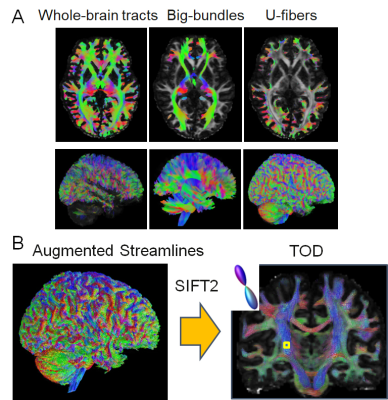 |
0392. Enhancing
Diffusion MR Tractography Using a Deep Learning Model that
Incorporates Anatomical Knowledge
Z. Liang, P. Filipiak, S. Baete, Y. Ge, L. Ying, J. Zhang
Bernard and Irene Schwartz Center for Biomedical Imaging, Department of Radiology, New York University School of Medicine, New York, NY, USA. , New York, United States
Impact: The proposed method can improve tractography by
reducing false-positives and benefit studies on structural
connectivity of the brain. Furthermore, it may shorten the
acquisition time required for robust tractography, which is
important for studies on children and seniors.
|
| 08:27 |
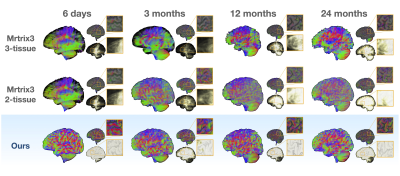 |
0393. Precision
Cortex Tractography for the Developing Brain

K. Huynh, S. Ahmad, G. Lin, P-T Yap
University of North Carolina at Chapel Hill, Chapel Hill, United States
Impact: Our tractography method outperforms commonly
used algorithms in generating accurate tractograms for
studying early human brain development.
|
| 08:39 |
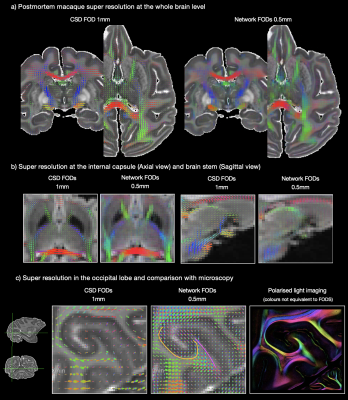 |
0394. A
microscopy-trained model to predict super-resolution fibre
orientations from diffusion MRI
S. Zhu, K. Miller, N. Dinsdale, S. Jbabdi, A. Howard
University of Oxford, Oxford, United Kingdom
Impact: We develop a microscopy-informed network that
provides super-resolved FODs from single-shell dMRI,
doubling the resolution. Notably, our network can be applied
to in-vivo MRI where microscopy is unavailable and offers
the possibility of more precise fibre tracking in widespread
applications.
|
| 08:51 |
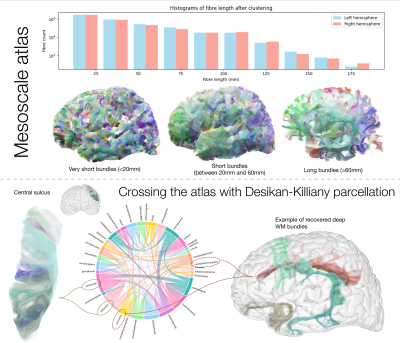 |
0395. A
200-micron structural connectivity atlas of the post-mortem
human brain using HPC global tractography on the Chenonceau
dataset

S. Legeay, F. Matuschke, B. Herlin, M. Axer, C.
Destrieux, I. Uszynski, C. Poupon
BAOBAB, NeuroSpin, Université Paris-Saclay, CNRS, CEA, Gif-Sur-Yvette, France, Saclay, France
Impact: This deep phenotyping approach represents a
significant advance in the human brain structural
connectivity mapping. Including subcortical and
intracortical connections at very high level of details, it
provides a valuable reference dataset for comparison with
conventional MRI tractography in
vivo.
|
| 09:03 |
 |
0396. Exploring
Consistency of Connectome Across Species Using Inter-bundle
Topological Graph Network (ibTGN)
Y. Zhai, Y. Xie, Y. He, T. Wang, X. Zhang, J. Qin, Y. Wu
Nanjing University of Science and Technology, Nanjing, China
Impact: This research will uncover potential homologous
pathways across species, shedding light on the evolutionary
and functional relationships in brain. Our method promises
to improve cross-species brain mapping protocols, enhancing
accuracy in neuroimaging studies related to brain
connectivity, cognition and evolution.
|
| 09:15 |
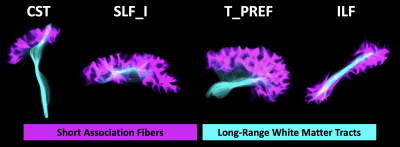 |
0397. Mapping
Short Association Fibers in Relation to Long-Range White Matter
Tracts Using Quantitative Diffusion Tractography
C. Cho, M. Chamberland, N. Newlin, E. McMaster, J. Yoon, D.
Moyer, B. Landman, K. Schilling
Vanderbilt University, Nashville, United States
Impact: This study provides novel insights into the
structural connectivity of SAFs in relation to LR tracts.
Furthermore, the quantitative volumetric analyses of
bundle-specific SAFs establish normative distributions,
which will serve as necessary baselines for future studies
in disease states.
|
| 09:27 |
 |
0398. The
Sense of Smell atlas: from creation to the first application for
investigating COVID-19-related anosmia with quantitative
multimodal-MRI

M. Gaviraghi, E. Lupi, E. Grosso, A. Fusari, M.
Baiguera, A. Monteverdi, M. Battiston, F. Grussu, B.
Kanber, F. P. Carrasco, R. S. Samson, J. Makaronidis, M.
C. Yiannakas, E. D’Angelo, F. Palesi, C. A. Gandini
Wheeler-Kingshott
University of Pavia, Pavia, Italy
Impact: For the first time, a comprehensive olfactory
circuit atlas with regions and anatomically realistic tracts
is presented. This atlas combined with analysis at regions
and voxel-wise level on multimodal-MRI maps, lays the
foundation for understanding the mechanisms of
COVID-19-related anosmia.
|
| 09:39 |
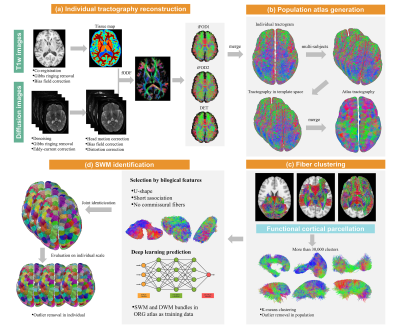 |
0399. Multifaceted
Atlas of Superficial White Matter Pathway Using Ultra‐High‐Field
Diffusion MRI
Y. He, Y. Hong, Y. Xie, T. Wang, J. Qin, Y. Wu
Nanjing University of Science and Technology, Nanjing, China
Impact: This research offers the most detailed segmented
multifaceted SWM atlas currently available in the existing
literature, which provides future researchers with a
high-quality data resource for studying the structure and
function of SWM, thereby further deepening our understanding
of SWM.
|
| 09:51 |
 |
0400. Mapping
and visualization of white matter deformation in glioma patients
using deep learning
B. Shams, L. Fekonja, P. Vajkoczy, T. Picht, D. B. Aydogan
Charité – Universitätsmedizin Berlin, Berlin, Germany
Impact: Detecting and mapping white matter deformation
is important for understanding the impact of gliomas on
brain structure and its associated deficits.
|
| 10:03 |
 |
0401. COMMITpro:
accurate modeling of diffuse axonal fiber degeneration using the
Discrete Cosine Transform
G. Mari, M. Battocchio, S. Bosticardo, I. Gabusi, A. Daducci
University of Verona, Verona, Italy
Impact: COMMITpro enables
accurate reconstruction of microstructural features in both
healthy and damaged brain pathways, offering valuable
insights into brain diseases and their progression by
identifying various types of fiber pathway damage.
|
The International Society for Magnetic Resonance in Medicine is accredited by the Accreditation Council for Continuing Medical Education to provide continuing medical education for physicians.